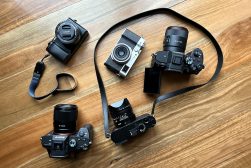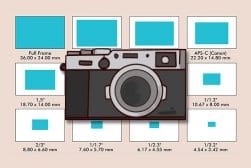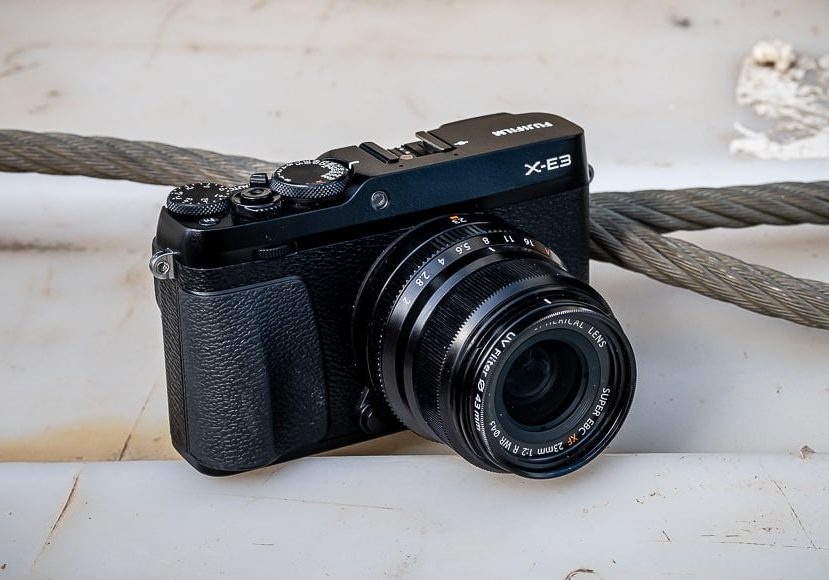
Fujifilm X-E3 Camera Review
Check out our in-depth, real-world Fujifilm X-E3 review to find out why this compact mirrorless camera is such great value for money. Highly recommended!
I have been a Fujifilm shooter for a number of years now with my very first experience with a Fujifilm camera being the original Fujifilm X100.
What a pure and simple joy that camera was to shoot with. The ability to have full creative control of all the necessary functions of my camera was transformative. It reminded me of my days shooting with 35mm film back in art school.
Not long after this first experience, I was struck even more by the ergonomic form and function of the Fujifilm X-T1. Those early experiences resulted in my dropping all of my DSLR gear and big heavy glass in favour of the mirrorless Fujifilm X Series Cameras.
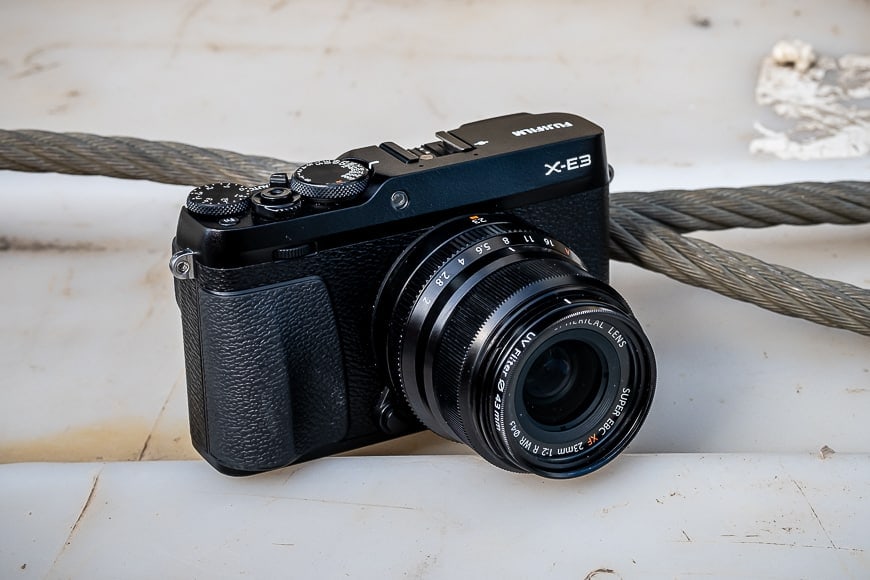
Feature-packed compact mirrorless camera with exceptional image quality at an affordable price.
The Fujifilm X-T1 was followed by the Fujifilm X-T2 and again the Fujifilm X-T3 , each on their respective launch days. Whilst this is not the article for my love of the X-T range, the story is important…
Until recently I had opted to not even consider a Fujifilm rangefinder-style camera such as the Fujifilm X-E3. However, this underrated neat little package of a camera has some great tricks up its sleeve.
Let’s jump straight into my Fujifilm X-E3 review.
Fujifilm X-E3 Specs
- Size and weight
- Exceptional autofocus performance
- Fantastic image quality in any condition
- Feature-packed just like a Fujifilm flag-ship body
- Fiddly SD card slot
- Tripod mount could obscure access to the battery and SD card slot door
- 24 Megapixel X-Trans™* CMOS III sensor & X-Processor Pro
- Touchscreen operation
- Focus Lever for selecting focus points
- 3.0-inch touchscreen LCD (1,040K-dot)
- 2,360K-dot OLED colour viewfinder
- Wireless communication with Bluetooth®**
- 4K Video recording
- Single SD card slot
- 121.3mm (W) x 73.9mm (H) x 42.7mm (D) 32.4mm / 4.78″ (W) x 2.91″ (H) x 1.68″ x (D) 1.28″
- 337g / 11.9 oz. (including battery and memory card)
Build & Appearance
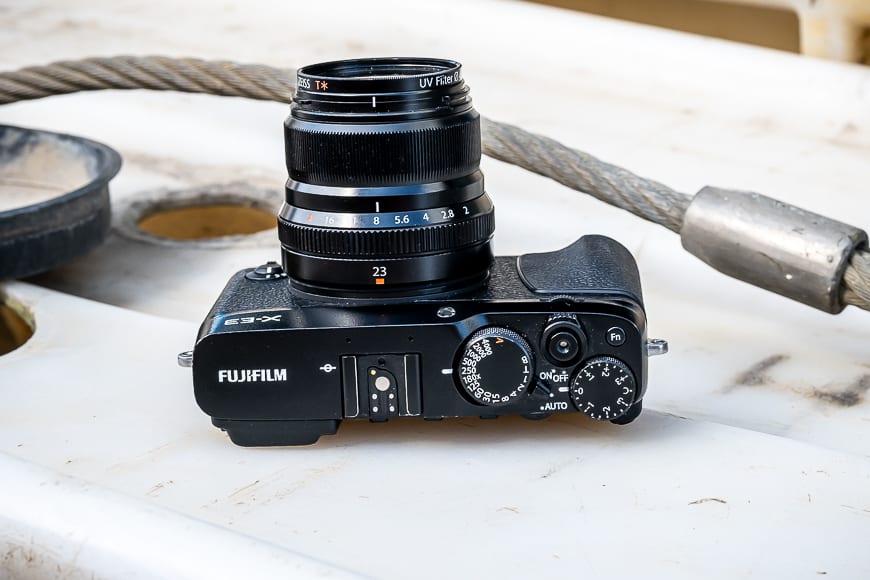
The Fujifilm X-E3 has a solid build and fully accessible controls
The Fujifilm X-E3 is a neat compact camera but not so small as to make the average user feel clumsy, thanks to some clever design choices.
Even with a battery and SD card onboard, the total weight of the camera is only 337g. Whilst a toy-like size and weight, there is nothing toy-like about the Fujifilm X-E3.
The overall design of the Fujifilm X-E3 is that of a flagship Fujifilm X Series camera body. It takes heavy design qualities from the likes of the Fujifilm X-Pro2 and the Fujifilm GFX 50R – both rangefinder-style bodies in their own rights.
The overall construction of the Fujifilm X-E3 is that of a metal body – a firm-textured skin on all sides and a sturdy rubber grip on the front. Solid metal lugs protrude from each side of the camera body giving assurance for connecting the most delicate or rugged of camera straps.
There are only two access doors on the camera body. The first is on the left side and offers a 2.5mm video mic jack, a Micro-USB port and a micro HDMI port. The access is neat, firm and closes snug against the body, keeping in mind that the Fujifilm X-E3 has no weather sealing.
The second access door is located on the bottom plate of the camera body. This houses the standard Fujifilm NP-W126S batteries and a single SD card slot. Personally, I found that the card slot being so snug against the battery made it difficult to get the card out.
Further to this, the battery / SD card slot door is located close to the screw mount located on the bottom base plate of the camera. This would make changing batteries or SD cards difficult if the camera was mounted to a travel tripod or some similar accessory.
The Fujifilm X-E3 has the same 3.0-inch touchscreen LCD (1,040K-dot) as the flagship model Fujifilm X-T3 . The touchscreen is bright, clear and responsive. This is critical given that Fujifilm has removed the age-old D-Pad from this camera, relying instead on touch swipes to access key functions.
The Fujifilm X-E3 has a 0.39-in, 2,360K-dot OLED colour viewfinder. It has a lower magnification rate compared to the flagship Fujifilm X Series cameras. Keep in mind that this is not a flagship camera, but the quality is still great.
Ergonomics & Handling

The Fujifilm X-E3 supports all Fujifilm X mount lenses
Despite this being one of the smaller Fujifilm X Series camera bodies, the Fujifilm X-E3 just feels well-balanced in the hand. There is no burden to carrying this camera be it on a neck strap or a wrist strap. Or, if you are brave, no strap at all.
Fujifilm’s decision to remove the tradition D-Pad from the rear of the camera was at first questionable. However, after getting hands-on with this camera, it is clear that this was not a flippant decision. The increased thumb real-estate gives the shooter greater comfort and grip of the camera.
As with all Fujifilm X Series cameras, there has been careful consideration given to the placement of buttons and dials on the camera body. In keeping with other cameras such as the Fujifilm X-Pro 1 & 2, the Fujifilm X100 series and even the Fujifilm XF-10, the Fujifilm X-E3 has a Shutter Speed and Exposure Compensation dial dominating the top plate.
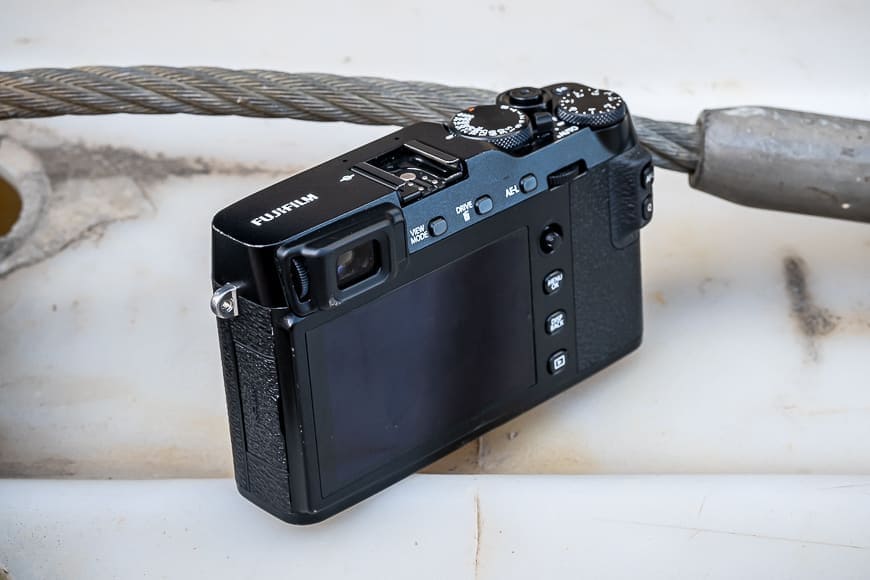
That consistency of design is greatly appreciated, as when picking up the Fujifilm X-E3, there is an automatic recognition with the design and familiar usability too.
The same can be said for the menu system – it is typical Fujifilm X Series in its layout and familiarity. The same menu styling that is in place across the entire Fujifilm X Series range.
As with most Fujifilm X Series cameras, the placement of major and minor control dials, buttons and thumb real-estate have been carefully calculated. Ergonomically everything is well within your reach. It is this kind of form and function that made me fall in love with my first Fujifilm X100.
Being such a lightweight camera with a great range of smaller and lighter Fujifilm X Series lenses available to it, carrying the Fujifilm X-E3 as an everyday camera or even your second body will have no noticeable impact on your comfort.
Without a lens, the camera is pretty much pocketable… and that is an impressive feat for a camera so heavily packed with features.
Focus Performance

Fujifilm X-E3 + Fujifilm XF 23mm f/2| 1/500 f/8 ISO400
The focus performance on the Fujifilm X-E3 camera is fantastic. This is largely thanks to the incredible capabilities of the X-Trans CMOS III sensor & X-Processor Pro. Keep in mind that this sensor and processor is only the generation behind the current flagship sensor and processor on the Fujifilm X-T3 .
The Fujifilm X-E3 provides multiple focus mode settings: Single-mode, continuous mode and manual focusing are all selectable from the same front selector switch available on every Fujifilm X Series camera.
Autofocus frame selection includes Single Point with adjustable frame sizes, Zone autofocus and Wide / Tracking auto performance.
From a practical stand-pint, and depending on the lens attached to the camera, the autofocus on tthe Fujifilm X-E3 is slick and precise. In each mode, the Auto Focus is quick to grab the intended subject and stick to them.
Another great feature of the Fujifilm X-E3 is that it allows for various eye and face autofocus settings. This includes setting the focus to grab either the left or right eye.
Low light focus performance seems to be just as effective as during daylight. In dark settings, with the right lens, the autofocus still grabs its subjects without hunting for purchase.
Low Light Performance

Fujifilm X-E3 + Fujifilm XF 23mm f/2| 1/125 f/8 ISO6400
When it comes to low light performance, the Fujifilm X-E3 doesn’t bat an eyelid. Or a shutter.
Over the years of using Fujifilm X Series cameras, I have never had an issue with shooting in low light. It is an area that Fujifilm has really made a commitment to control effectively.
Walking into a dark setting, I can happily dial in the ISO via the swipe function on the rear touch screen.
Reading the room and light, I comfortably dial the ISO to 6,400 while still holding an aperture of F8 and a shutter speed of 1/125. The level of noise from such a composition is truly minimal.
Image Quality

Fujifilm X-E3 + Fujifilm XF 23mm f/2| 1/250 f/4 ISO3200
Keeping in mind that the Fujifilm X-E3 is using the prior generation of sensor and processor, the image quality is exceptional. This is the same generation as the Fujifilm X-T2, the Fujifilm X-Pro2 and a bunch of other older Fujifilm bodies. It is definitely no slouch.
It is well known that Fujifilm SOOC (Straight Out Of Camera) JPEGs are simply amazing, with exceptional image quality and rendering. The Fujifilm X-E3 is no exception to that family heritage of high-quality JPEG reproduction.
Personally, I always shoot in RAW as I like to add my own variant of Fujifilm Film Simulations in Lightroom during post-production. We will talk about that another day.

Fujifilm X-E3 + Fujifilm XF 23mm f/2| 1/1000 f/8 ISO400
The RAW files are highly malleable, and images can be recovered from the most under-exposed images imaginable. The Fujifilm X-E3 is no exception to this.
Images from this camera are crisp and sharp – of course, a lot of this is reliant on the lens attached to the camera body. Fortunately, the Fujifilm X Series lens line up is yet to produce a terrible lens.
Overall Performance
I mentioned that the Fujifilm X-E3 is no slouch. In terms of overall performance, this is a serious contender to the other Fujifilm X Series camera bodies.
The Fujifilm X-T2, Fujifilm X-Pro2 are flagship bodies that this little camera with its much lower price point can keep pace with and then some.
The start-up time for the Fujifilm X-E3 is only 0.4 seconds, which is super quick for a mirrorless system. But seriously, how fast do you need it? Further to this, the camera has a mechanical shutter speed up to 1/4000.
At a continuous shooting level with the electronic shutter, the Fujifilm X-E3 can keep pace with 14 frames per second. Using the mechanical shutter, it can comfortably capture 8 frames per second.
In the testing I did with continuous shooting, SD card buffering were not an issue at all. I grew tired of the subject long before the camera grew tired of writing to the SD card.
Other Useful Features
In terms of video production, the Fujifilm X-e3 has some pretty impressive capabilities. While not marketed as a video camera, it is no let down should you choose to put it to the test and shoot high-quality video.
Personally, I am not a video shooter and would not pick up this camera for anything other than still photography… but for those interested in a camera that can produce excellent quality video, the Fujifilm X-E3 has the capability that is desirable.
It can shoot 4K at 29.97P at 100Mbps continuous recording up to approximately 10 minutes. Even I know that is a decent output.
Value for Money

Fujifilm X-E3 + Fujifilm XF 23mm f/2| 1/250 f/2 ISO1600
So here is the deal and probably the deal maker for a lot of shooters interested in taking up a top of the line Fujifilm X Series camera. Let’s look at some comparisons first.
The Fujifilm X-T2 camera body, last generations, retails for around $1,600. The Fujifilm X-Pro 2, in serious need of a new generation release, retails for around $2,000. Both of those prices are for the body only.
The humble little Fujifilm X-E3 has exactly the same sensor and processor as those two flagship Fujifilm X Series cameras. And, being a more recent release than either, has the latest and greatest firmware updates and inclusions.
From a pricing perspective, the Fujifilm X-E3 currently retails for around $1,000 – hundreds of dollars less, yet with equal capabilities as the previous generation flagship bodies.
This price point makes the bundled versions of the Fujifilm X-E3 with either the kit Fujifilm X-E3 + XF 18-55mm F/2.8-4, or my recommendation, the Fujifilm X-E3 + XF 23mm F/2 still cheaper than the Fujifilm X-T3 body only offering.
The maths doesn’t lie – this camera is excellent value for money.
Fujifilm X-E3 Review | Conclusion
I mentioned at the start of this Fujifilm X-E3 review how I have mostly overlooked the rangefinder style of Fujifilm X Series camera in place of the Fujifilm X-T series.
While I have no real regrets about that decision and pathway, I must caution others that this was a mistake. Along the way, a true gem appears and deserves its own level of consideration and attention.
The Fujifilm X-E3 is an incredible camera packed full of high-end features into a teeny tiny body that you could genuinely drop into your back pocket and not know it was there until you went to sit down.
As\dd a Fujifilm X Series lens of any kind to this camera, and you have a highly capable, adaptable and high quality combination.
Having tested this camera over several weeks, I have found it very hard to find anything but joy in my shooting experience. The Fujifilm X-E3 has met every challenge I have thrown at it with a small silent smugness that is simply adorable.
The only thing that may sway your decision if you’ve read this far is the latest model – see more in my Fujifilm X-E4 review.

Feature-packed compact mirrorless camera with exceptional image quality at an affordable price.








